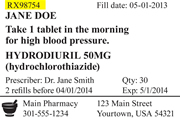
TUESDAY, Oct. 9 (HealthDay News) — Confusing dosing instructions for prescription drugs cause more than a million medication mix-ups a year in the United States, but experts say proposed labeling changes could slash that number.
The U.S. Pharmacopeial Convention (USP) — a nonprofit group that often sets drug safety standards — is proposing a major reworking and standardizing of the medication labels Americans read every day.
“So many people make mistakes taking their medicines,” said Dr. Joanne Schwartzberg, director of aging and community health at the American Medical Association and a member of the USP’s Nomenclature, Safety and Labeling Expert Committee.
Many mistakes result from dosing directions that simply aren’t clear to patients, she said. For example: “Take two pills twice daily,” to many patients means “take two pills a day,” rather than the intended instruction of taking a daily total of four pills, Schwartzberg explained.
“That’s a mistake that [even] college-educated people make. The words are very simple, but understanding what they mean can be a problem,” Schwartzberg said.
Prescription drug labeling can also differ widely from drugstore to drugstore, she added, and the new labels are an attempt to standardize information for patients.
For example, one drugstore in Chicago printed labels for one patient that offered different instructions for each drug — “PO” (doctor-speak for “take by mouth”); “take by mouth;” “take orally;” “take per oral route.”
“We say use one phrase [consistently], let’s not confuse people,” Schwartzberg said.
Labels changes the USP would like to see include:
- Keep the drug name, clear patient instructions and dose prominently displayed in clear, large type at the top of the label. Place less important data (pharmacy name, drug quantity) away from dosing instructions.
- Avoid confusing dosing instructions: For example, write,
“Take two tablets in the morning and two tablets in the evening” instead of “Take two tablets twice daily.” - Avoid ambiguous directions, such as “take as directed.”
- If listing the purpose of the drug, use simple terms. For example, “for high blood pressure” instead of “for hypertension.”
- Take the patient’s first language into consideration. If possible, except for the drug’s name, the label should be in the patient’s language of choice.
The proposed changes are “fantastic and long overdue,” said Diane Pinakiewicz, president of the National Patient Safety Foundation. “Will it be perfect and solve everything? No, but it will take us a long way down that path.”
Studies show that 46 percent of patients misunderstand the instructions of prescription drug bottles. The problem is especially acute for patients with poor reading skills. In fact, these patients are 34 times more likely to misunderstand the label direction, one study found. In addition, when a patient is taking several medications — all with different directions — the problem gets even worse.
Even highly literate patients, however, make mistakes because label directions are confusing, Schwartzberg said.
The new label recommendations were undertaken in response to an Institute of Medicine (IOM) effort to improve “health literacy,” which is the ability to get, process and understand basic health information and services needed to make informed decisions about heath.
According to the IOM, 77 million Americans have limited health literacy and most have difficulty understanding and using available health information and services.
Will the new clearer labeling reach your local drugstore? Schwartzberg said that whether or not the USP recommendations are adopted remains up to each state’s board of pharmacy. But she noted that states have typically adopted recommendations from the group before on other pharmaceutical issues.
And Schwartzberg noted that at its 2012 annual meeting, the National Association of Boards of Pharmacy passed a resolution supporting state boards in requiring a standardized prescription labeling.
“It will take time, but I think it will be adopted,” she said.
“We certainly respect USP,” John Norton, a spokesman for the National Community Pharmacists Association (NCPA) said. “Their recommendations for standards are carefully considered by NCPA and the more than 23,000 independent community pharmacies we represent.”
Norton agreed that label changes must occur “in the context of what’s in the patients’ interests in terms of health literacy, visibility and whatever information is necessary to promote adherence.”
However, “from the standpoint of our members, we are concerned with what’s reasonable for a small pharmacy business owner to carry out — for example, the different language translations, font size, label size, etc.” he added. “We want to be as constructive and cooperative as possible balancing all of those concerns and will continue bringing our ideas to the table.”
In the meantime, Schwatrzberg said, doctors and pharmacists can help make sure that each patient understands the medication they are taking, and how they should be taking it.
More information
For more information on understanding drug labels, visit AARP.

